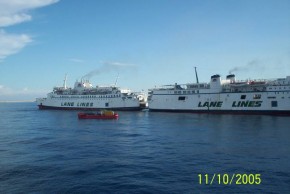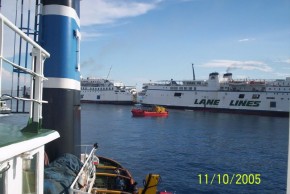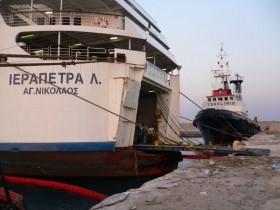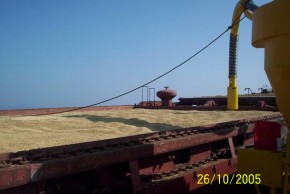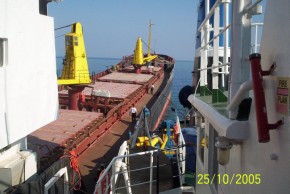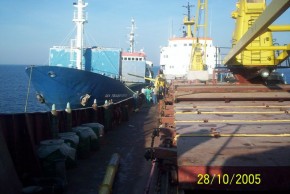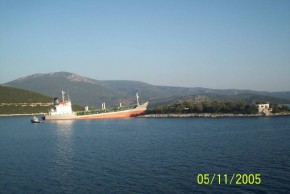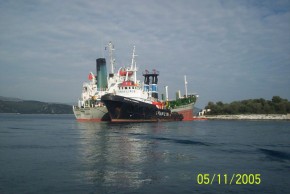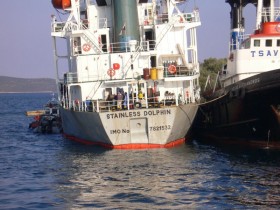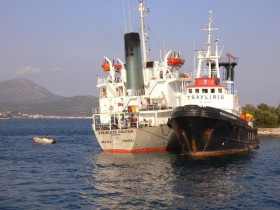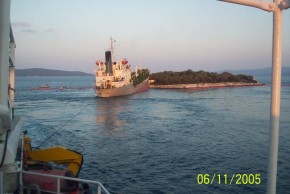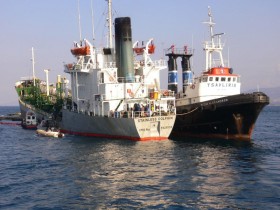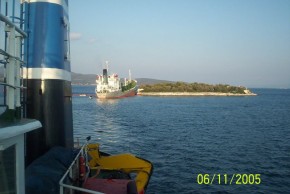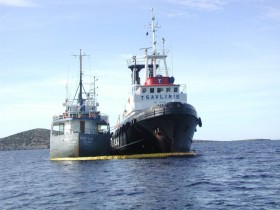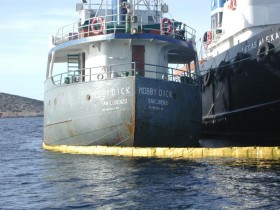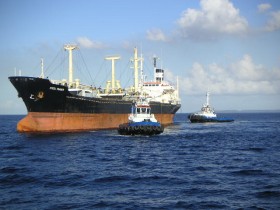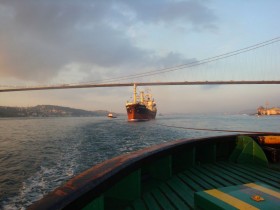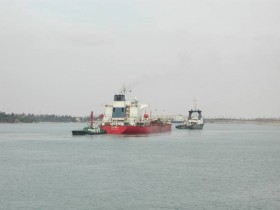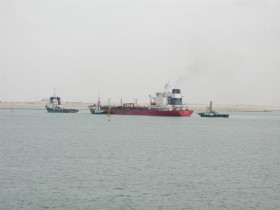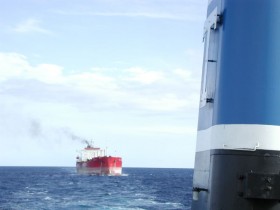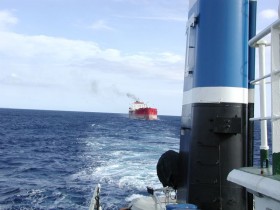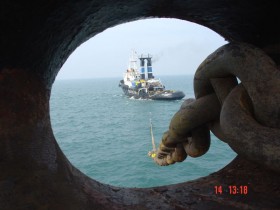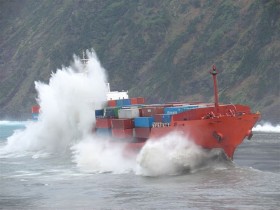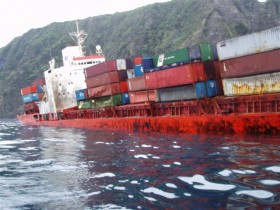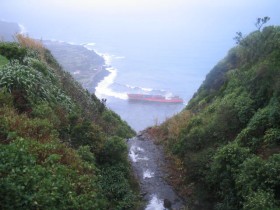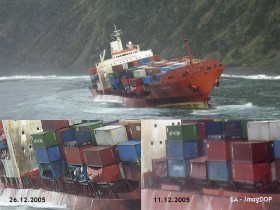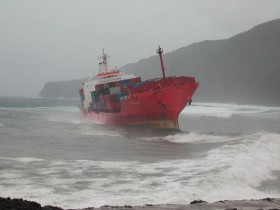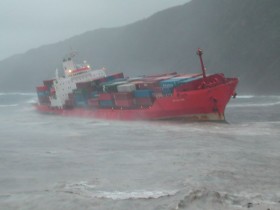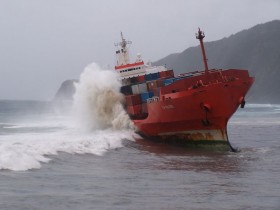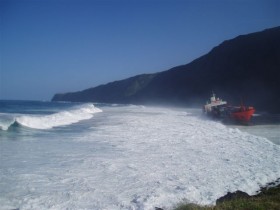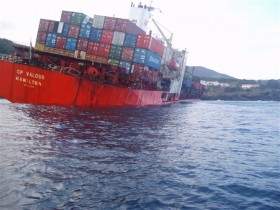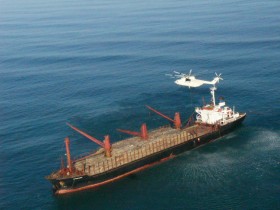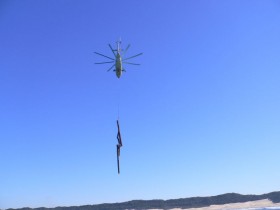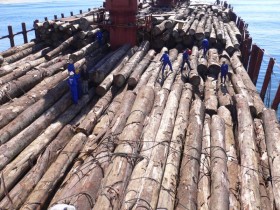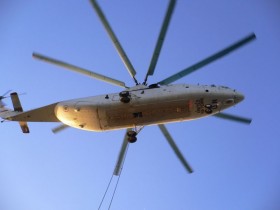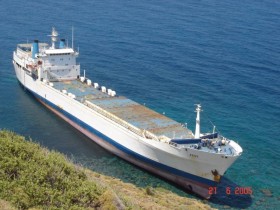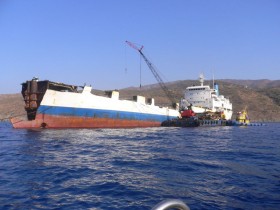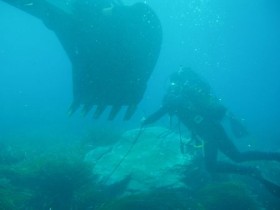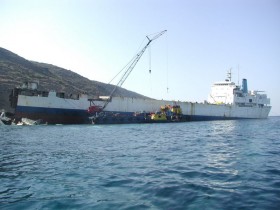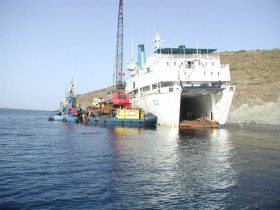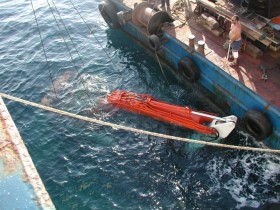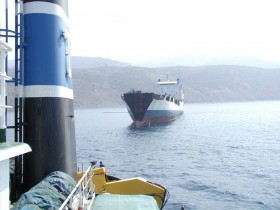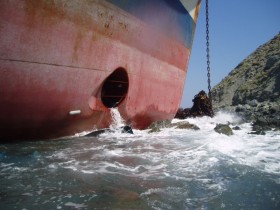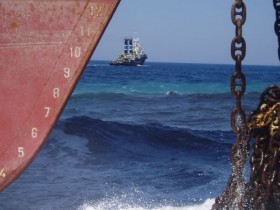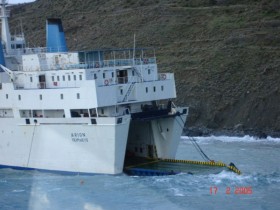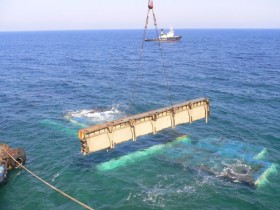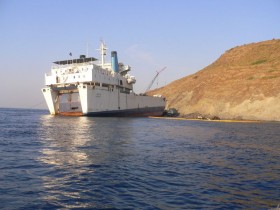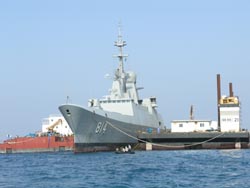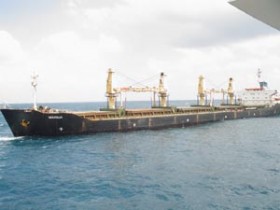Operations List
The 16.000 dwt general cargo "HUI LONG" - laden with paper pulp, zinc ingots and sunflower seeds - had suffered a seriously list to port due to cargo shifting 250 miles of Sri Lanka . All 23 crew members were rescued by a German vessel "NEDLLOYD ASIA" on 18th May.
TSAVLIRIS after signing a LOF agreement immediately send off S/T "SB 408", together with a salvage master and naval architect . The salvage plan was to tow the casualty to Sri Lanka for about 3 days . Upon arrival, a towing connection was established and towage commenced to Sri Lanka .In the mean time however, the condition of the casualty was deteriorating and the list increased up to 45 degrees to port side .While preparation for a diving inspection the list of casualty rapidly increased and the vessel eventually sank on May 20. Despite TSAVLIRIS prompt response, salvage services were terminated on the same day.
When the scheduled ro-ro passenger ferry "IERAPETRA L" grounded on October 9th off the port entrance of Rhodes, TSAVLIRIS responded the same day, mobilizing the salvage tug "MEGAS ALEXANDROS" from Piraeus and another ro-ro ferry, "VITSENTZOS KORNAROS" from Alexandroupolis.
The replacement ferry was moored stern to stern and ramp to ramp with the casualty and the 37 vehicles onboard were discharged, while bunkers from the casualty were also transferred. Patching, pumping and pressurizing were performed, and the casualty was pulled afloat by the "MEGAS ALEXANDROS" with the assistance of local port tugs before being taken to the port of Rhodes for further patching and underwater repairs, followed by towage on to Piraeus.
The 4,700 dwt cargo ship "SEA HAWK II" had run aground on a reef north of the island of Lesvos while on a voyage carrying wheat and barley from Constantza to Larnaca. TSAVLIRIS mobilized the salvage tug "MEGAS ALEXANDROS" from Piraeus together with a salvage team and lightering equipment. A small vessel was also chartered from Izmir for lightering of about 1,000 tonnes of barley of vacuvator.
After lightering and removal of bunkers, the casualty was successfully refloated and taken to Lesvos. Following extensive underwater repairs and patching to the satisfaction of the authorities and class, the casualty and balance cargo were delivered to Lesvos. Eventually, lightened cargo was transferred by salvors to its destination in Larnaca.
During a busy period for casualties in the Aegean, a 4,200 dwt chemical/oil carrier "STAINLESS DOLPHIN" ran aground north of Evia Island while on a voyage to Syria laden with 2,000 tonnes of sunflower oil. TSAVLIRIS immediately dispatched "MEGAS ALEXANDROS" and "NESTOR", together with a salvage master and diving team. After performing patching and dewatering on site, and transferring cargo and bunkers that were onboard, the casualty was successfully refloated and afterwards taken to Stylida for further patching.
Highlights of the three-month period until the end of 2005 also included TSAVLIRIS' late-November salvage under a LOF (with SCOPIC) of the cargo vessel "MOBY DICK", abandoned in the Aegean Sea in bad weather after her cargo hold began flooding. The salvage tug "MEGAS ALEXANDROS" was mobilized from Piraeus and towed the vessel to Levitha Island, where she was anchored, patched and pumped dry.
The casualty, which was on a voyage from Odessa to Beirut with a cargo of steel pipes, was later towed to Rhodes for redelivery to her owners.
In the Caribbean, two tugs were dispatched from Martinique and Port of Spain, together with divers and welding gear, to assist the 16,270 dwt general cargo vessel "STEEL TRADER". The vessel, that was immobilized in ballast condition about 20 miles north of Barbados, was towed by a first tug to Kingstown where a second tug took over the operation, its five-strong team of divers performing temporary repairs on the rudder and securing it amidships.
The casualty was then towed to Curacao.
Other successes in December included the refloating of the bulk carrier "MOUNT ATHOS", which ran aground in the Orinoco River during a voyage with 26,000 tonnes of iron briquettes. Two local tugs were mobilized from Puerto Ordaz and a salvage team dispatched for the operation, which freed the vessel in a few days using a combination of scouring and pulling.
At the same period the 40.000 Chemical Product Tanker Vessel "ANTONIS A." was immobilized while northbound in the Suez Canal, due to heavy structural contact damages at her bow and her rudder. She was laden with 37.548,455 m/t of palm-oil, with destination Mersin and Odessa. LOF was signed with TSAVLIRIS on 15th December 2005.
A salvage team was dispatched from Piraeus immediately, and S/T "MEGAS ALEXANDROS" sailed on the same day from Piraeus in order to assist to repairs and then tow the vessel to Mersin-Turkey for discharging. Diving-Working Tug "SALAH ELDEN", S/T "MONKAZ 1", two Service Boats, additional diving team consisting of 10 divers and a team of 12 fitters were also hired for the extensive underwater repairs, which lasted over a period of 10 days and were completed on 5th January 2006.
After 4 days of sea trials, vessel sailed on 10th January 2006 towed by Suez Canal tugs to Port Said anchorage, where S/T "MEGAS ALEXANDROS" took over and transferred the vessel to Mersin 18th January 2006. Once discharge will be accomplished, vessel will be towed by "MEGAS ALEXANDROS" to Elefsina-Greece for dry dock repairs.
In a particularly challenging operation that lasted for most of December, TSAVLIRIS was engaged to salve the 1,000 TEU container vessels "CP VALOUR" that ran aground in the Azores during bad winter weather.
Arriving from permanent salvage station in Ponta Delgada, the salvage tug "FOTIY KRYLOV" made a number of refloating attempts but these were unsuccessful as the casualty was hard aground with her double bottoms flooded. Prior to further refloating efforts, the site was dredged and the vessel was prepared for pressurizing.
To minimize pollution, the salvors contracted a tanker from Gibraltar to remove the remaining bunkers from the casualty and although the removal operation started immediately after the tanker's arrival on December 20, the transfer could not be completed due to a sharp deterioration of the weather.
Salvors had also mobilised a geared multipurpose vessel to lighter containers from the casualty but in Christmas storms the "CP VALOUR's" condition deteriorated rapidly, forcing the boarding team to abandon the casualty for safety reasons.
During the next inspection, the ship was found to have lost almost all buoyancy, and had a significant list to starboard. Refloating by conventional means was no longer a possibility, nor was lightering an option, so the lightering vessel was released. Priority was now given to three deck containers with hazardous cargo which posed a significant environmental threat if lost or damaged.
A Hazardous Material Handling Team of five from the Netherlands was organised to handle the goods and a dismantled "KAMOV-32" helicopter was brought by transport from Bucharest to the Azores and reassembled. All dangerous cargo was successfully and safely unpacked onboard the casualty, airlifted to shore by the "KAMOV-32" (for heavy items) and a Portuguese Puma (for lighter parcels), and repacked without incident, despite atrocious weather and sea conditions.
After removal of the hazardous goods, the "KAMOV-32" also played a vital role in completion of efforts to remove all pumpable bunkers from the casualty. In a continuous operation, bunkers were pumped into portable tanks, airlifted to shore where they were transported by road to the port, discharged into the tanker and airlifted back to the casualty for refilling. This, too, was completed on New Year's Eve and TSAVLIRIS was demobilised, with the casualty becoming subject to a wreck removal contract. While Tsavliris' salvage team was still engaged on the operation to free the CP Valour, three new LOF contracts were signed in the space of just one week in mid-December.
In one of the latest and most challenging cases, the group was contracted to salve the 25,500 dwt bulk carrier "KIPEROUSA", that ran aground near East London, South Africa, resulting after the flooding of her engine room. Engaged under a LOF contract with Scopic, TSAVLIRIS mobilized the 25,000 bhp mega-salvage tug "NIKOLAY CHIKER" and a 40-man salvage team in early June and was successful in removing all bunkers/pollutants, de-watering flooded areas including the engine room, and preparing the casualty for refloating. As the vessel was heavily aground and could not be refloated by conventional pulling, the LOF/Scopic was terminated and TSAVLIRIS was awarded the continuation of the services under a wreck removal contract.
In early July, a heavy lift helicopter joined the extensive array of salvage equipment and vessels already deployed for the operation, and began the process of removing deck cargo – about 6,000 tonnes of the vessel's total 23,000 tonne cargo of logs. A Russian Mi-26 helicopter, the heaviest and most powerful helicopter in the world, was hired for this phase of the operation, necessitated by the fact the site was unsuitable for bringing a lightering vessel alongside the casualty. The novel operation was expected to last two weeks and is intended to provide sufficient buoyancy to allow a successful refloating of the bulker later in July.
The RoRo "ARION" ran aground in Chios Island during a severe storm in February this year. Salvors engaged at the time under LOF removed the bunkers from the casualty but failed to refloat her, and the vessel became subject to a wreck removal invitation to tender.
TSAVLIRIS obtained the wreck removal contract and in association with Poseidon Diving mobilized on site a large array of salvage craft and gear including two tugs, two floating cranes and miscellaneous equipment. The refloating operation involves pulling with a combination of tugs and ground tackle, lightering, by means of cutting off parts of the deck and bow, and scouring with the use of an underwater hydraulic-powered track-mounted excavator. Extensive patching of the severely damaged bottom and pressurizing is also being performed to assist in gaining lost buoyancy. The refloating operation is expected to finish within the following weeks, and the vessel is bound to subsequently be delivered undertow to a scrap yard in Turkey.
TSAVLIRIS performed de-watering operations after the motor vessel "APOLLON" suffered engine-room flooding at Kynosoura.
TSAVLIRIS completed refloating of a frigate "HMS MAKKAH" , which ran aground on a reef in the Red Sea (about 80 miles north of Jeddah) just prior to Christmas. The delicate operation to free a state-of-the-art warship bristling with expensive electronics took more than two months, utilizing over 700 salvage personnel.
For the operation, Tsavliris was subcontracted by Huta Sete Marine, and undertook planning, management and supervision of the entire salvage operation. The multipurpose anti-air warfare frigate, newly built in 2004, was heavily aground with bottom contact in the mid-ships area over a length of 15-20 meters. The vessel's hull was breached during grounding with an estimated loss of some 1,400 tonnes of buoyancy.
Conventional approaches to refloating stranded merchant ships could not be applied in this project and using cranes to lift the vessel was excluded because of the warship's structural profile and sophisticated onboard equipment. Tsavliris' alternative salvage plan was based on providing additional buoyancy to enable refloating to take place without further damaging the vessel.
Initially, preparations for the project included: patching and dewatering of the frigate's flooded forward engine room, underwater inspections, outfitting of barges with bollards and equipment for securing τhe slings etc.
Then, two barges – "SETE 21" , a submersible deck cargo barge, and "TAHLIA" – took part in the refloating attempts, gradually applying tension to the sling arrangement of 16 steel wire cables of 56mm diameter passed under the hull of the frigate. These had to be positioned according to load pressure analyses and forces were further controlled through load distribution plates in order to protect the vessel's hull. Deballasting of the barges in a controlled operation in theory could free the frigate, but it became evident that further buoyancy was required.
This was provided by attaching buoyancy pontoons to the bow and stern of each barge, as well as binding cylindrical tanks to the bow of the vessel. Eventually sufficient buoyancy was achieved to allow the Tsavliris-operated salvage tug "SB-408" to gently pull the frigate from the reef and tow it to Jeddah for redelivery.
On 6th of October, Tsavliris dispatched S/T "LEOPARD" to assist the Derrick Barge "DLB-1" which started sinking off Dakar, while under tοw by the tug "Colbert".
TSAVLIRIS engaged in patching and dewatering services on commercial terms.
The 35.000 dwt Bulk Carrier "MARILIA" on her passage from Novorossiysk to Port Keylang, Malaysia ,laden with 33,000 tons of fertilizer, was immobilized due to generator failure approximately 700 nm Southeast of Socotra.
TSAVLIRIS salvage tug "SB-408" sailed from Colombo station to assist the casualty under Lloyd's Open form on February 7th. Bulk Carrier "MARILIA" was towed without incident and delivered successfully to Colombo berth on 20th of February for repairs.

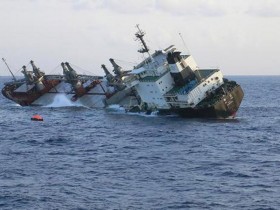
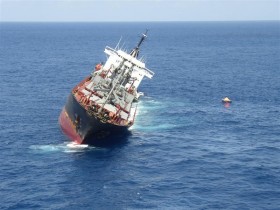
.jpg)
